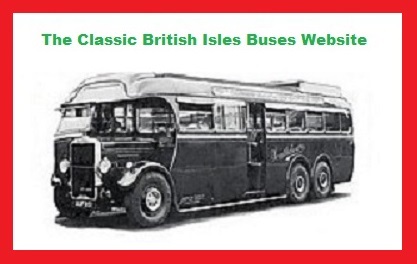

The Classic British Isles Buses Website
The Routemaster in 2004 and 2005 - the beginning of the end (by Shane Conway)
Last updated 7 August 2024

Email Events diary Past events list Classified adverts Classic U.K. Buses Classic Irish Buses Classic Manx Buses
The year 2004 saw both the 50th anniversary of RM1 and also a rundown in London's use of Routemasters in everyday service. In January 2004 seventeen routes were still using RMs, and by the end of the year ten of these had given way to new buses. Those routes surviving into 2005 were 13, 14, 19, 22, 36, 38 and 159. Whatever your feelings on the impending loss of the last traditional half-cab, two person operated buses, let's not forget just how long the RMs have been in use. RML2760, the last one, entered service in 1968, some 37 years prior to me writing this page, while the first production ones appeared ten years earlier than that. Given that the usual lifespan of a modern bus is 15 to 20 years, the RM family has therefore effectively had two lifetimes, a process helped by successive refurbishments, engine replacements, internal retrims and so on. Route 36 succumbed on January 28th 2005, followed by the 19 on April 1st 2005, then routes 14 and 22 on July 22nd. Of the three remaining, route 13 went on October 21st 2005, leaving the last two as 38 and 159.
In a way, the process reflects the era when the RMs were new, and were replacing the last London Transport trolleybuses, up to May 1962.
We start with a photo review of the RM50 display at Finsbury Park on July 24th and 25th 2004, and as much as this website editor would have loved to have made the trip to the RM50 display in person, personal committments were to dictate otherwise. So, our trusty associate photographer, Mr. Richard Gilbert, went instead, and took the following selection of views of some of the entries.
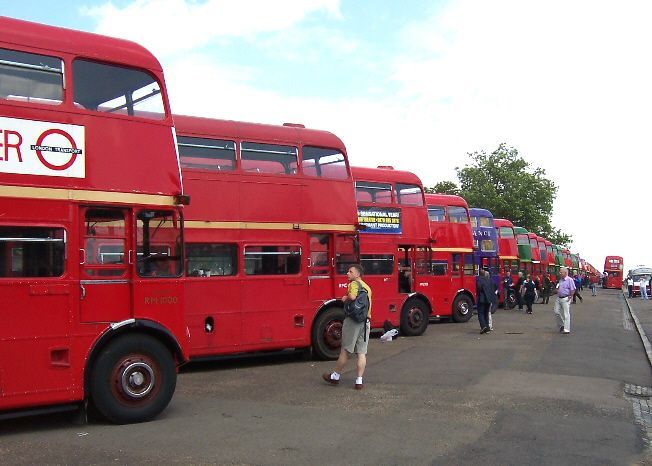
First, a multi-coloured line-up of some of the entries...... (Photo by Dick Gilbert)
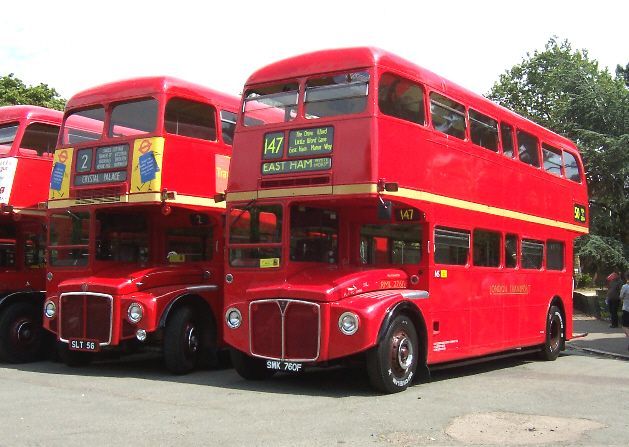
The first, and the last, RM1 and RML2760, side by side. 2760 entered service in February 1968, and passed to Stagecoach East London in September 1994. It has retained red livery, London Transport fleetnames, and an AEC engine. (Photo by Dick Gilbert)
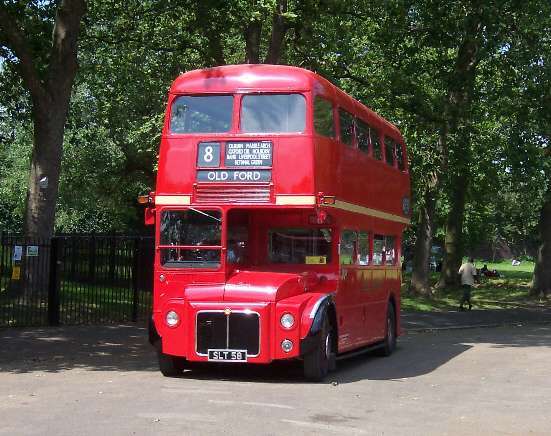
RM3 with its original style front. (Photo by Dick Gilbert)
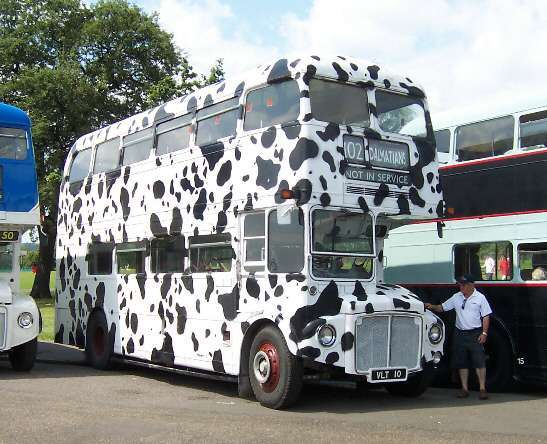
RM10 now carries dalmation livery, applied for filming of 101 dalmations in March 2000. The bus was originally new in August 1959 and was withdrawn in May 1985. It was re-registered XFF 258 in January 1996, but shows VLT 10 for display purposes in this photo. Alongside it is 1961 bus RM655, now owned by Confidence Coaches of Leicester. (Photo by Dick Gilbert)
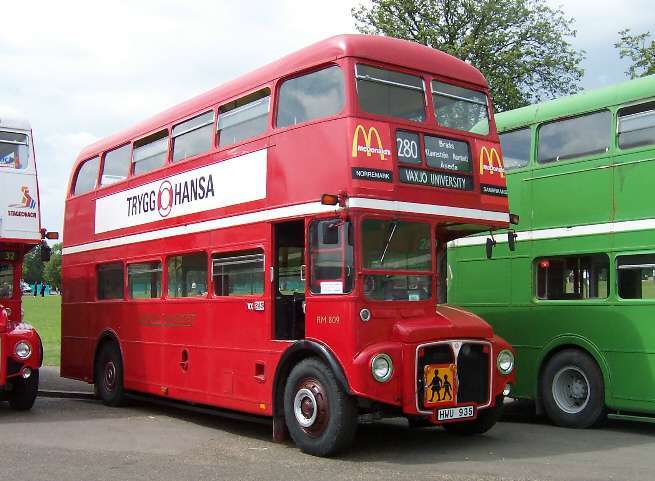
RM809 achieved 25 years of London service (July 1961 to August 1986) before being sold to the Scottish Bus Group in October 1986. From 1993 to 1996 it saw use in Bournemouth, and was exported to Routemaster Travel, of Vaxjo in Sweden where it was re-registered HWU 935. (Photo by Dick Gilbert)
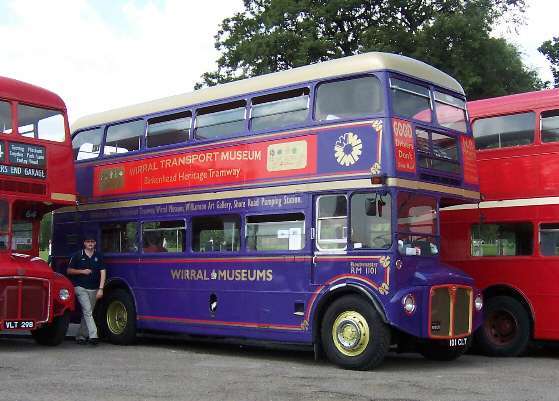
RM1101 arrived at Fulwell garage in May 1962, the same month as London's last trolleybuses were withdrawn. Re-engined with an Iveco unit in 1991, it passed to A1A Travel of Birkenhead in 1994 and went into preservation in 1998 with the Wirral Transport Museum. (Photo by Dick Gilbert)
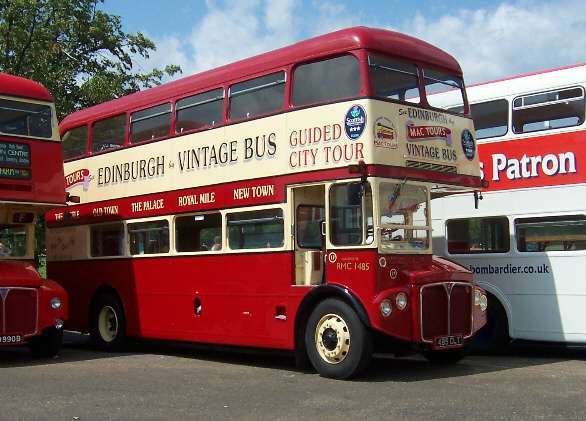
RMC1485 is one of 20 Routemasters operating in Edinburgh for Mac Tours. New in October 1962, it spent eight years at Windsor garage, followed by ten at Swanley before being re-acquired by L.T. in 1980. Eight years of training duties were followed by a refurbishment and use on commuter route X15, the bus later passing to Stagecoach East London in September 1994. It moved to Edinburgh in September 2003.(Photo by Dick Gilbert)
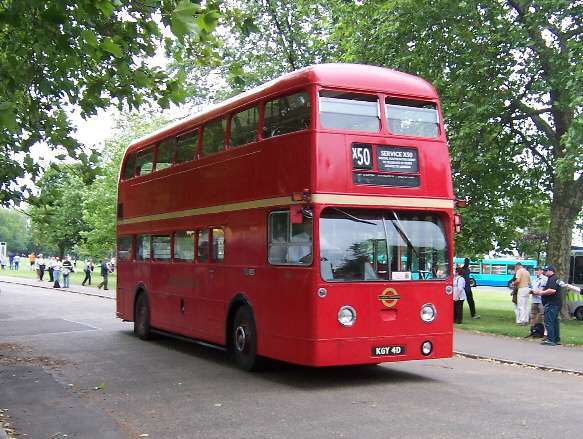
Finally, the unique rear engined 1966 bus, FRM1. (Photo by Dick Gilbert)
On September 3rd 2004, three further routes lost crew operation. These were:
9 Hammersmith to Aldwych; 73 Victoria to Stoke Newington; and 390 Marble Arch to Archway.
Route 9, operated by London United, saw the introduction of new East Lancs bodied Volvo B7TLs, some of these had in fact been already operating on the route with conductors.
Arriva's route 73 was converted to low floor Mercedes Citaro 3 door artics with pay before you board only - i.e. cash is not accepted on the buses. Boarding takes place through all three doors, and the buses feature air conditioning and c. c. t. v.
Route 390 is operated by Metroline.
A few views taken by Kevin Horgan follow to illustrate some of the last half cabs on Route 73.
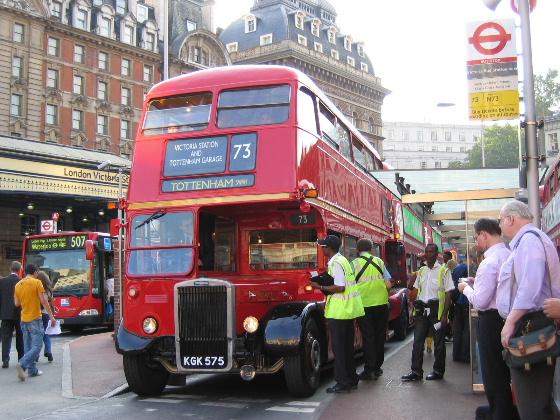
Freshly restored RTW75 took part in the last day of the 73. This bus, new in September 1949, is now owned by Blue Triangle of Rainham. Its L.T. career comprised almost 15 years service use and then six years as a South London driver trainer. Sold in January 1970, it re-appeared as a psv with Blue Triangle in May 2000, and has since taken part in several RM last day events. (Photo by Kevin Horgan)
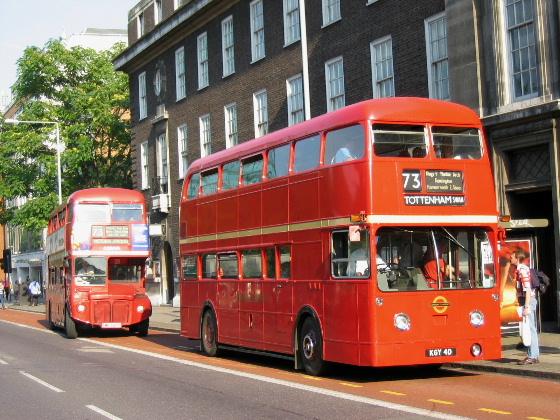
Another preserved bus, the sole rear-engined Routemaster FRM1, was also on Route 73 on the day, with a standard RM about to overtake the FRM. (Photo by Kevin Horgan)
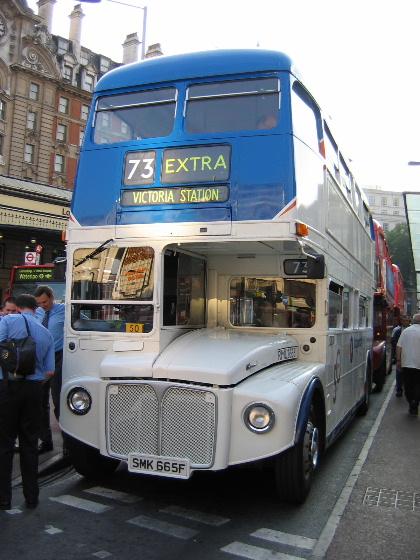
RML2665 was turned out by Stagecoach, its new livery contrasting with the red Arriva buses on the route. It was new in July 1967 and its first duty was a visit to a British week in Brussels in September 1967. It has worked from four garages, Croydon, Chalk Farm, Stamford Hill and Bow, the latter since it was acquired by Stagecoach in September 1994. (Photo by Kevin Horgan)
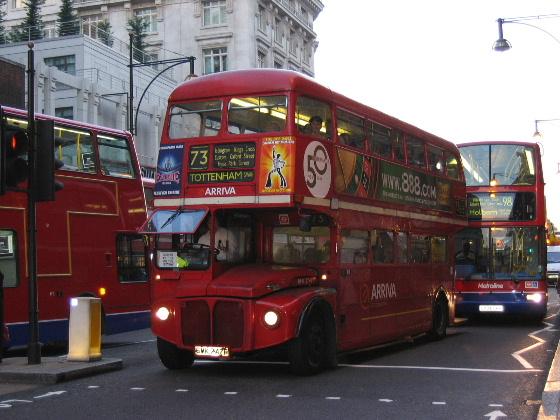
As 2004 could be said to be the twilight year of RM operation, here's a shot of RML2747 in the half light of a London evening. This was another of the overseas visitor buses, going to both Paris and Brussels in 1975. New in December 1967, it remained in service until September 2004, passing to a preservationist in January 2005. (Photo by Kevin Horgan)
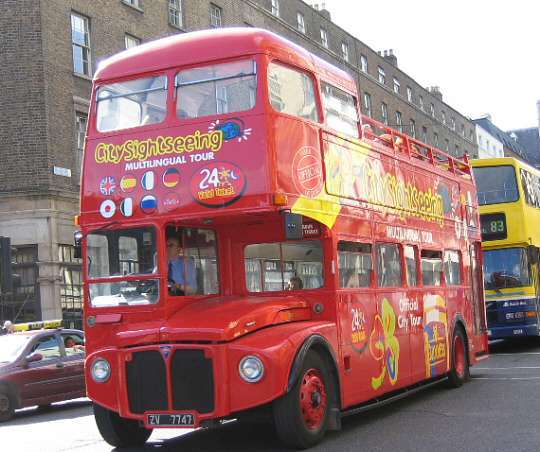
2005 has seen expansion of Routemaster operation away from the London area. Five RML class vehicles, or 1% of the 500 examples built after 1965 were acquired by Dualway Coaches in Dublin, where they joined two RMs and two RMAs already in stock. The RMLs are 2500, 2621, 2646, 2720 and 2729. By June 2005 three of them had been de-roofed and fitted with platform doors from some of the ex Dublin Bus Olympians also owned by the company. Here's a view of RML2646 (re-registered ZV 7747) on the Dublin City Sightseeing tour in D'olier Street, Dublin on June 18th 2005. (Photo by Kevin Horgan).
July 22nd 2005 - the cull continues.....
As mentioned above, routes 14 and 22 were scheduled to lose their last Routemasters on July 22nd 2005. With this in mind, a group of hardy souls decided to make the trip from Ireland for the last day. In my case, it meant rising at 04.00, leaving home at 05.00, and arriving at Dublin Airport at 06.00 for the 07.20 flight to Heathrow. Appropriately, the trip from the car park to the terminal was on a red Mercedes Citaro artic, similar to some of the newer vehicles in London service in 2005. After arrival at Heathrow and a second breakfast, one day all zones travel-cards were purchased and the Piccadilly line tube was boarded. Due to recent events in London, the trains were terminating at Hyde Park Corner, where the 14 and 22 could both be accessed.
At this stage it was 11.20, so when an RML appeared on route 14, we boarded it for a 14 minute (appropriate!!) journey to Tottenham Court Road. The bus turned out to be RML887, resplendent in the old London General livery. Its one of the original two dozen RMLs of 1961, the ones which worked alongside trolleybuses on route 609 or 104 as it later became.
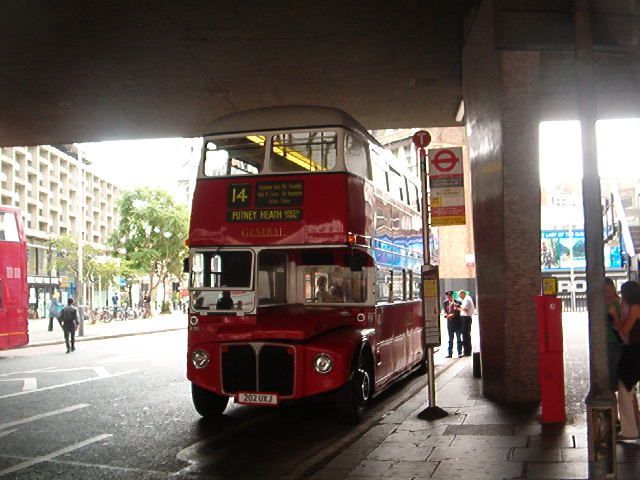
A list of extra journeys with guest buses (such as RML887) had been published on the LOTS website, but there seem to have been some last minute changes to the plans. Quite unexpectedly, a Greenline RF class bus came along displaying route 22 scrolls, and passed by. Now, this wasn’t on the list, yet it had a conductor on board and was carrying passengers, but the 22 starts from Piccadilly Circus, not Tottenham Court Road..... We decided to board RML887 again, and after about 10 minutes we suddenly realized that the RF was in service. So a very quick change of vehicle (aided by the open platform of the RML), and we settled down in the back seats of the RF. It turned out to be RF48 which originally entered service in November 1951, and a notice inside informed us that it was a free service in memory of a deceased conductor, and not, as suggested on another website, a special run with invited guests. On this vehicle (which remained in service until February 1976) we had a very comfortable 40 minute journey to Putney Bridge, arriving there around 12.40.
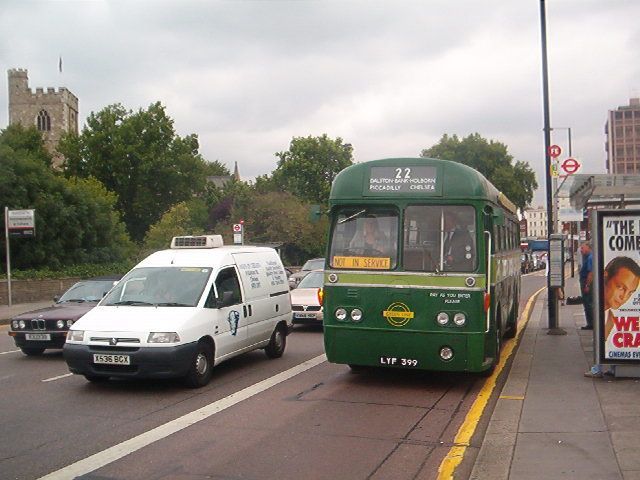
This was the only single decker (or for that matter, the only underfloor engined bus) which took part in the day's event. Photographing some of the old and new buses going up and down Putney High Street was next on the agenda. Even though this was officially the last day of Routemaster operation on the two routes to Putney, newer buses had already slipped into use with conductors, I suppose this somehow softens the blow.... The replacement buses were Wrights Gemini bodied Volvo B7TLs, and looking around me as these vehicles, along with similar chassis fitted with East Lancs bodies, made me wonder what on earth Frank Pick would have made of it all. Some of the RMLs which appeared looked very careworn, adverts removed, even this sad specimen (RML2299, new in September 1965) with the paint rubbed off some of its roof panels, and what looks like a jammed opening window towards the rear. One of the Wrights bodied buses (on route 430) is about to overtake it. This has a modified design where the two offside windows at the top of the stairs are a different size to the rest of the bus.
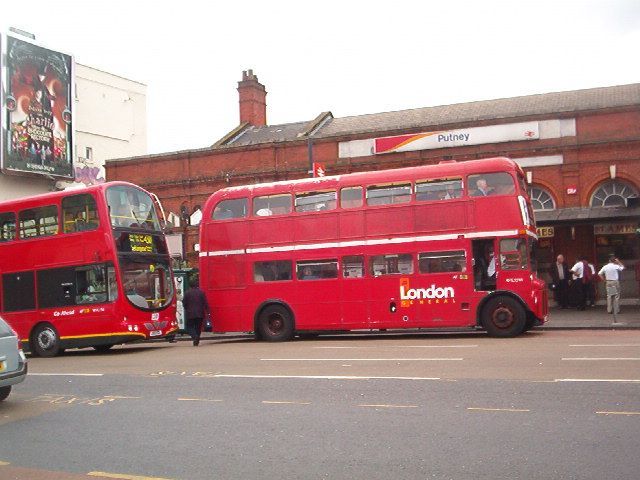
The next surprise appearance was of the Cravens bodied RT1431 heading towards Tottenham Court Road, but as it passed by it was observed to be full to the seams, so we had to let it pass. This one has a roof box body, was new in May 1949, and last operated in regular London service in August 1955, yes, just over six years!!!. Unlike the majority of the RT class, the Cravens version had five window bays in the lower saloon. This bus then passed to A1 Service of Ardrossan, and went into preservation in February 1966. Acquired by Ensignbus in January 2005, it was restored as a psv and used alongside Routemasters for the first time ever!

Having been passed by several heavily laden half cabs, I decided to jump on an RML and head up to the 14 terminus at the Green Man public house. The next trip was to be on RT1702, only as far as Putney Bridge though. The 13 minute journey (14.12 to 14.25) was my first ever time to travel on an RT, this one being new in 1950. When new, it was one of the select few which toured Europe to promote the Festival of Britain in 1951. Putney Green Man to Putney Bridge seems much more mundane by comparison.
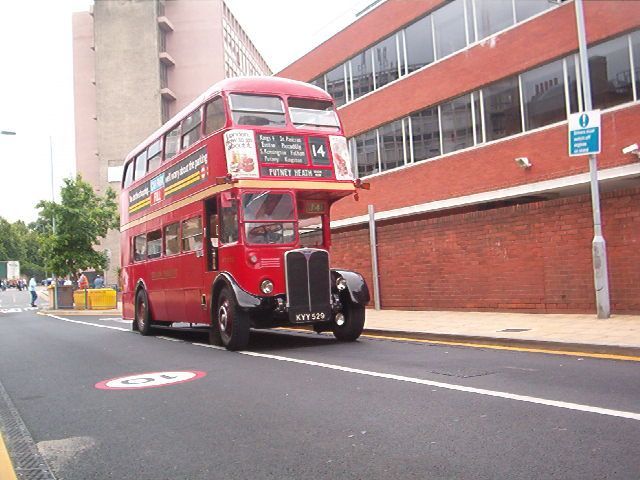
At this stage two hours had elapsed since leaving the RF, and as we had passed RTW75 going the other way, I reasoned it should be well on the way back to Putney by now. Another 13 minute journey (this time on RML2520) gave an arrival time of 14.42 at Green Man, the RTW then obliged by turning up to do what was scheduled as the 14.36 departure, some 24 minutes late. However it was worth waiting for. Internally it differed from the RT by having the extra width (8 feet wide instead of 7'6"), but apart from that, it would be difficult to distinguish between them, especially in the sound department.
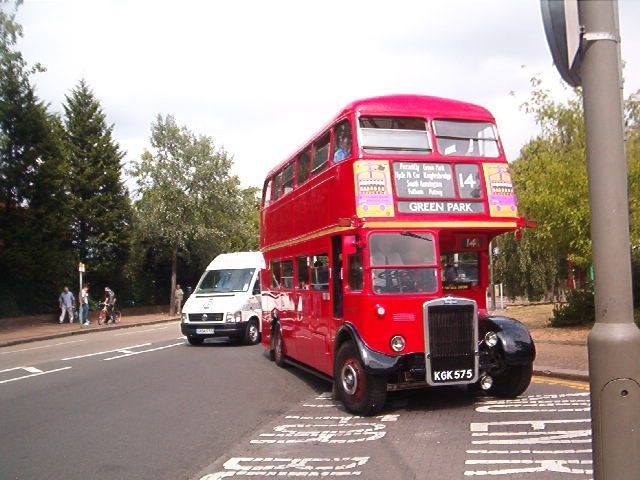
As can be seen in the above photo, the RTW was to terminate at Green Park, presumably to try and regain some of the lost time. En route I discovered that there would be one of the pre-war STL class AEC Regents on display at Green Park for about an hour. The bus in question turned out to be STL2377 (EGO 426), new in November 1937, and was brought from the London Bus Preservation Trust collection in Cobham.
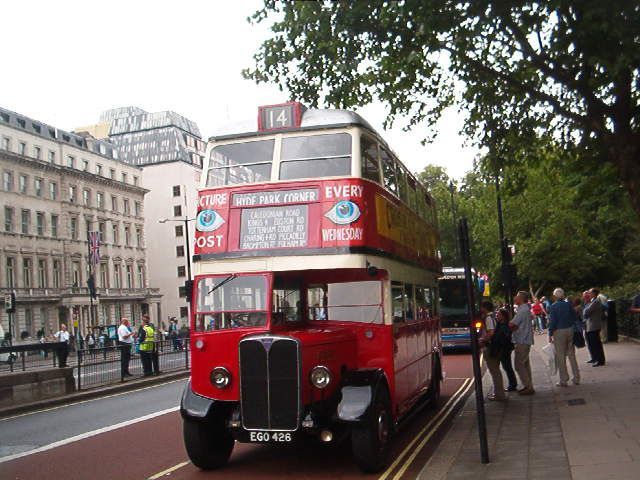
At this point it was time to take stock of the day's events. I had already travelled on three RMLs, the RF, RT and RTW, as well as the tube from Heathrow. RM9, RML2317 (in green), RT1431, and a further bus listed as a surprise owned by Ensignbus had yet to be sampled. The snag was I didn’t know what the mystery vehicle was..... Onto other matters, it was time for a late lunch, and having filled that need, I walked back towards the 14 stop in the hope of catching RT1431 which was due. It didn't disappoint me with its punctuality, but I was several yards from the stop when it passed me by, for the second time that day. The nearest traffic lights ahead of the bus were also out of reach.... I then encountered the next RML on the 14, number 2314 which I boarded at 17.12, but on arrival at Tottenham Court Road at 17.28 found the RT had already departed. To make matters worse, the elusive green RML also passed 2314, again going the other way. Two missed buses within ten minutes...... My pondering what to do next at the 14 terminus was suddenly answered when a number 38 bus pulled up. This time it was one of the shorter RM type, RM2060, the one and only example I travelled on all day. Although the 38 terminates at Victoria, this one was turned short at Piccadilly Circus, so I decided to walk back towards Hyde Park Corner again. On the way though, a few surprises still awaited me.
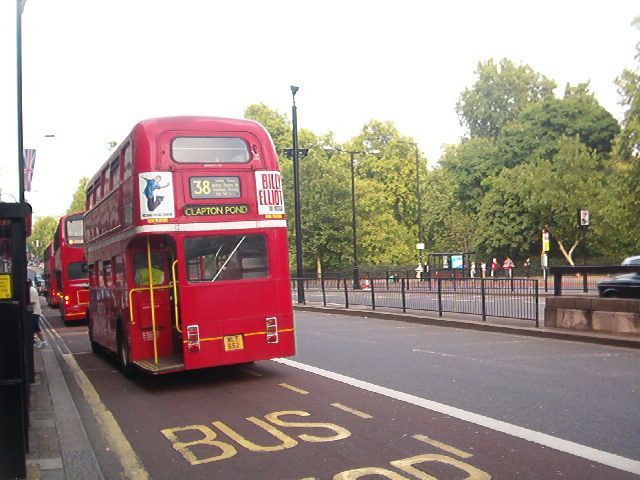
None more so than this particular vehicle, which was the very first bus sold to the former Scottish Bus Group back in 1985. It joined the Clydeside Scottish fleet at that time, and was one of those vehicles which were allocated names beginning with R, this one becoming Rodney and it was also re-registered LDS 161A in Glasgow. After Glasgow service it was preserved for some years in Chesterfield (during which the registration was changed back) with a couple of East Midland service stints for Christmas shoppers in Mansfield in 1991 and 1992. It resumed London service in March 2002, after a gap of 17 years. More RMLs and RMs were snapped on the remainder of the journey to Hyde Park, with one gem still to show up.....
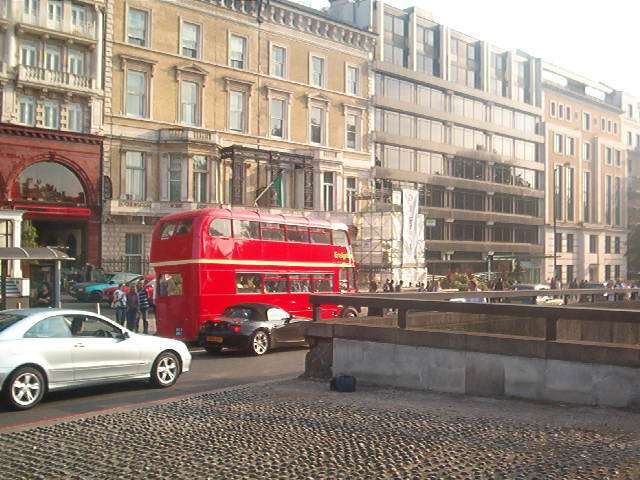
.....My tiredness was suddenly interrupted when THIS appeared on the opposite side of the street. RLH61, one of the last lowbridge buses to run for London Transport, was what had been billed as the Ensignbus mystery vehicle. At this stage it was running on route 22, bound for Putney Common. At the same time, RM216 also passed by on the other side of the same road, lettered for Memory Lane Omnibus Services.
So, that was July 22nd 2005, and with it went two more London bus routes operated by Routemasters. Gone also are further conductors jobs (although one chap on the 14 didn't seem to be too put out by his impending redundancy); gone is yet another link with the days of Frank Pick, AEC, Park Royal, even London Transport itself; gone are more vehicles which replaced some of London's last trolleybuses in the early 1960s; even phrases such as hold tight, any more fares, and seats on top, are edging ever closer to the history books...
Route 13 (Aldwych to Golders Green) saw what seemed to be a low-key finale for its half cab buses. New buses, in the form of East Lancs bodied Scanias had begun operating prior to the last day, thus diluting the sense of occasion that was evident on the 14 and 22 last day, three months earlier. A few photos kindly supplied by Patrick Losty help to sum up the day.
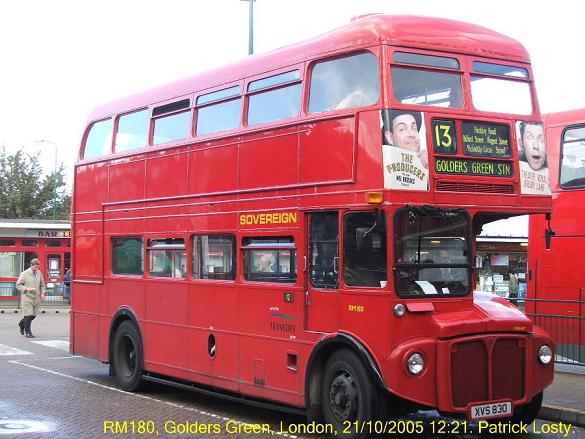
RM180 is now one of the few surviving examples of the VLT registered buses, albeit re-registered as this one has been.
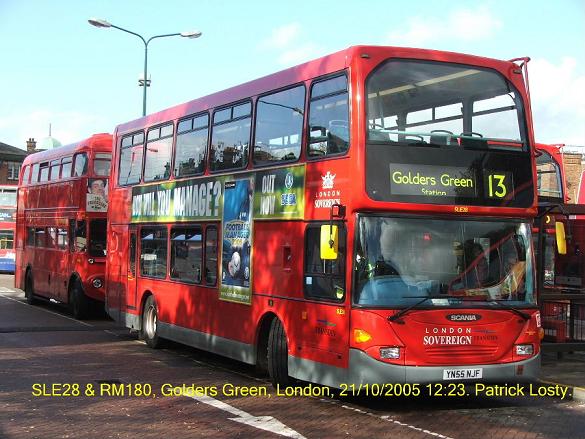
Representing the new order is SLE28 (YN 55 NJF), with a different dash and windscreen to that applied to the same bodies when built on Volvo chassis.
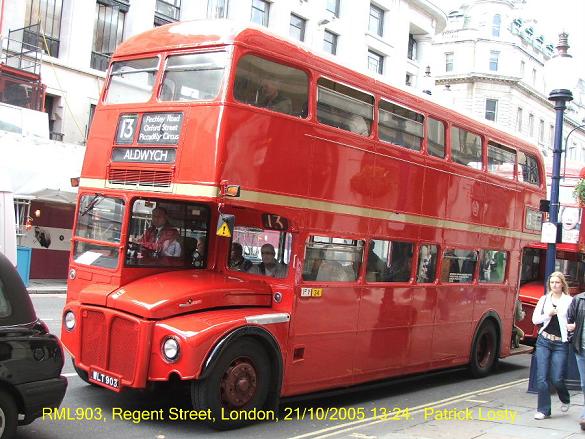
RML903 put in an appearance also. As the one time Finchley garage showbus, I remember seeing this very bus when it made an official trip to Dublin in 1988.
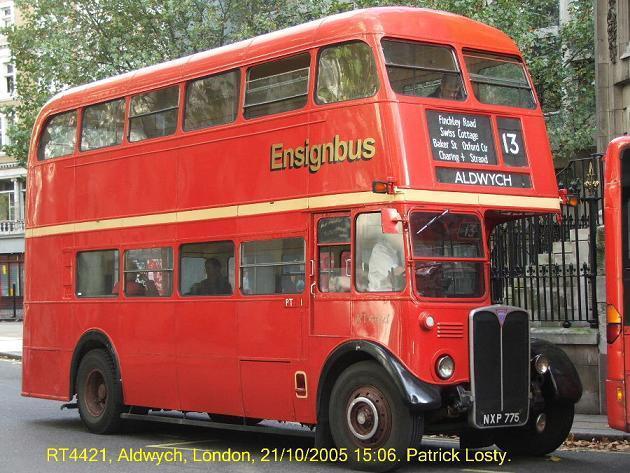
Ensignbus chipped in with RT4421, as seen at Aldwych during the afternoon.
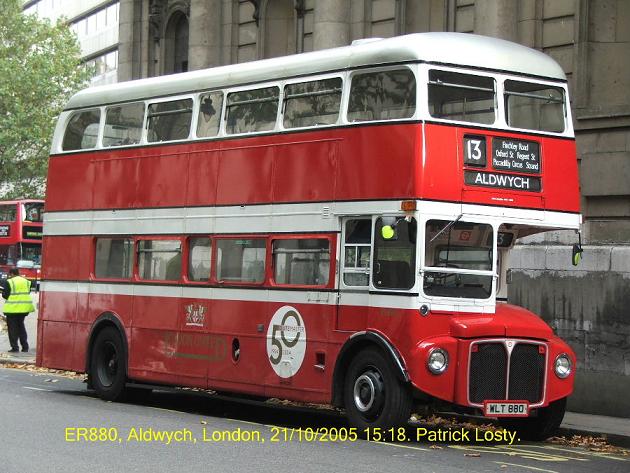
And finally, RML880 of London United was pictured at the same place as the RT, just a few minutes later. Unlike many of its sisters, this one has managed to retain its chrome headlamp surrounds and wheel rings.
38's last day of Routemasters, October 28th 2005
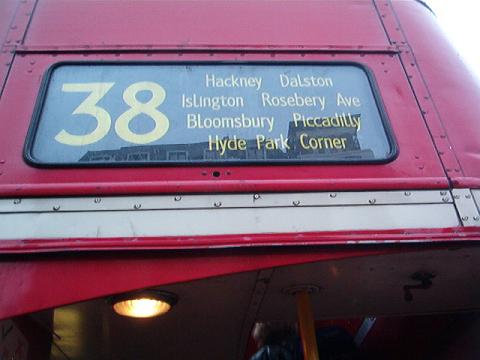
October 28th and another London bus route loses its half cabs, and conductors. Rather than the hectic schedule of trying to cover the event in one day (as happened in July for the 14 and 22 change-over), the more leisurely approach of getting there the day before was used instead, followed by two overnights in a hotel, and a flight home at a reasonable hour.
So the multi-modal journey outbound comprised a Bus Eireann VC class coach, an Aer Lingus A320, and two tube trains, followed by a somewhat overpriced meal in the basement of a pub, the menu board for which was located right at the top of the steps. It would be a first if I was to fall INTO a pub, so care had to be taken while trying to read the menu.
Anyway, I got into Victoria early on Friday morning and found several Routemasters lined up at the 38 terminus. I decided to try and travel on as many buses as possible, both regular Arriva ones, and the extra guest vehicles. A summary of my wanderings is listed below. Of these, bus 17600 was a Stagecoach vehicle on route 55, used when there was a delay to the 38 schedule. Interestingly the first bus out, and the last one back (on which I travelled), were both former Blackpool Transport examples, as was SRM3 (RM1650). That bus, with its Silver Jubilee 1977 sign-writing and silver paintwork, caused confusion at several stops, where waiting passengers were presumably expecting a red bus. A hoped for evening trip on RT190 going to Clapton was forsaken at the last minute, in favour of a much more interesting vehicle, namely RMF1254. What I discovered later (although in hindsight I suppose I could have figured it out that night) was that (amid all the last Routemasters on the 38) this particular bus was putting in its FIRST day's work on a London bus route, a mere 43 years after it was built.
| Bus no. | From | To |
|
RM1640 |
Victoria |
Cambridge Circus |
| RML2355 | Tottenham Court Road | Rosebery Avenue |
| RT3062 | Roseberry Square | Clapton Pond |
| SRM3 | Clapton Pond | Clapton Garage |
| 17600 | Clapton Garage | Clapton Pond |
| RM298 | Clapton Pond | Clapton Garage |
| RML900 | Clapton Garage | Tottenham Court Road |
| RT1431 | Tottenham Court Road | Green Park |
| RML2386 | Green Park | Victoria |
| RM613 | Victoria | Piccadilly Circus |
| RML2401 | Piccadilly Circus | Victoria |
| RM909 | Victoria | Green Park |
| RT190 | Green Park | Victoria |
| RMF1254 | Victoria | Clapton Pond |
| RM848 | Clapton Garage | Victoria |
It seemed though, that some of the regular travelling public were almost unaware of the impending change from Routemasters to bendi-buses. There were leaflets available at Victoria about it, and posters at some of the tube stations, but still it came as a sad surprise to many. Outside Clapton garage I was even asked by a passer by as to why so many people were taking photos, and it transpired the gent in question had absolutely no idea that the change was just hours away. He wasn't the only one..... And at least the wheelchair using part of the population will now be able to use the 38, which will be an improvement to their lives. Whether this type of bus is the most suitable vehicle for a route like the 38 remains to be seen though.
Even though the route remained 100% Routemaster to the end, several of them were back in Clapton garage before 9 p. m., had their blinds removed, and departed again, presumably for storage elsewhere. A sad convoy indeed..... As I settled down in my seat on RM848, I felt a bit of emotion that this was most likely the last time I would ever travel on a Routemaster in ordinary London service, it truly was the end of an era.
The schedule went seriously out of line in the late evening, as a 200 strong cycle rally at Piccadilly Circus actually drew a crowd of 2000. For a time at Victoria there were no buses at all on the 38 stand, which given the frequency of the service, was very unusual. The late evening also brought repeated requests from supervisory staff at Victoria for photographers not to use flash for moving vehicles in the interests of driver safety.
Although there was still some RMs on the road until after midnight, I decided to call it a day by 11 p. m. A Metroline bus on route 24 was boarded for the hotel trip (Hutton's in Pimlico), but very quickly had to take a diversion due to a traffic accident - the manoeuvre involved passing a junction and then attempting to do a three point turn in the road to approach it from the other side, with an approaching fire tender added in for good measure.
An attempt was made to record the various Arriva Routemasters, and their running numbers during the day, however I can't claim that it is 100% accurate. A reshuffle occurred during the late morning when RM1312 failed at Clapton Pond, and several following buses were switched to other duties and crews to make up for the shortfall. So some duties were covered by two (or more) buses (in the order shown), and others by one. My thanks to Matt Wharmby's London Bus Page site for extra information to help fill in the gaps. From this table it appears that 55 buses were in use in total to cover the 50 duties.
| Duty no | Bus | Duty no | Bus | Duty no | Bus |
| 101 | RML2328 | 102 | RML2325 RML2526 | 103 | RML2526 RML2356 |
| 104 | RML2356 RM1145 | 105 | RM1145 RML888 | 106 | RML888 RML2416 |
| 107 | RML2416 RML2408 | 108 | RML2408 RML2675 | 109 | RML2675 RML2546 |
| 110 | RML2546 RML2571 | 111 | RML2571 RML2528 | 112 | RML2750 |
| 113 | RML2528 RML2315 | 114 | RML2315 | 115 | RML2370 RML2562 |
| 116 | RML2562 RM1968 | 117 | RML2597 | 118 | RML2280 |
| 119 | RML2277 | 120 | RML2280 RM909 | 121 | RM909 RML2401 |
| 122 | RML2344 | 123 | RML2259 DLA15 | 124 | RM1312 RML2494 |
| 125 | RML2494 RML2492 | 126 | RML2492 | 127 | RML2386 RML2567 |
| 128 | RML2567 RML2366 RML2638 | 129 | RML2638 RML2346 | 130 | RML2346 RM1640 RML2534 |
| 131 | RM1640 RML2534 RM1640 RML888 (last run) | 132 | RML2534 RML2655 | 133 | RML2534 RML2355 |
| 134 | RML2355 RML2334 | 135 | RML2334 RML2325 | 136 | RM2050 |
| 137 | RML2434 | 138 | RM848 | 139 | RM2122 |
| 140 | RML2528 RML2525 | 141 | RML2406 | 142 | RM2060 |
| 143 | RML2688 | 144 | RML2408 RML2409 | 145 | RM1185 RM848 |
| 146 | RM1776 | 147 | RML2304 | 148 | RM1941 |
| 149 | RM652 RM1941 | 150 | RM1164 | ||
| Others Seen | RML2503, RML2752 (running numbers not recorded) | ||||
| Guest buses (not all carried passengers), and their owners | |||||
| RM5 | Arriva | RM6 | Arriva | RM298 | Blue Triangle |
| RM613 | Private | RML900 | Blue Triangle | RMF1254 | Private |
| SRM3 | Centrewest | RML2097 | Private | RML2665 | Stagecoach |
| RML2760 | Stagecoach | RT190 | Private | RT191 | Cobham |
| RT1431 | Ensignbus | RT1702 |
Private |
RT3062 | Blue Triangle |
| RT4421 | Ensignbus | ST922 | Cobham | RLH61 | Ensignbus |
| RTW75 | Blue Triangle | HLJ 44 | Ensignbus (Hants and Dorset Bristol) | ||
So now Routemaster operation in London is down to route 159, plus the two new heritage routes from November onwards. What began on a drawing board back in 1947, and first appeared in full size form in 1954, has now just about reached the end of the road in terms of providing a bus service in London. Considering that the first production buses went into service in the summer of 1959, and that the first ten of them all still exist (with three of them still used as p. s. v.s), it's been an enviable record that they have lasted in service until 2005, a total of 46 years service.
Consider too that half cab operation in most other cities and towns throughout the British Isles ended many years ago, e. g. Belfast in 1975, Dublin in 1982 and Birmingham in 1977 to list but three. Against this the Routemaster just kept on going, outlived succeeding purchases of rear engined double deckers which were intended to replace it, and even managed to re-introduce half cab use across Great Britain in the 1980s. One by one though those operators, and now each London route in turn, have all succumbed to new buses. What you feel about the loss of RMs depends on your viewpoint, depending on whether you're a driver, conductor, maintenance person, transport manager, enthusiast, passenger, or wheelchair user. At the end of the day, the objective for any bus company is to provide a regular reliable service, and modern low floor vehicles are the way of the future, like it or not. However, I think it's a fairly safe bet that although the Routemaster has now almost gone from London, its story is far from over. It is hoped to keep this site updated from time to time with interesting photos or stories of Routemasters.
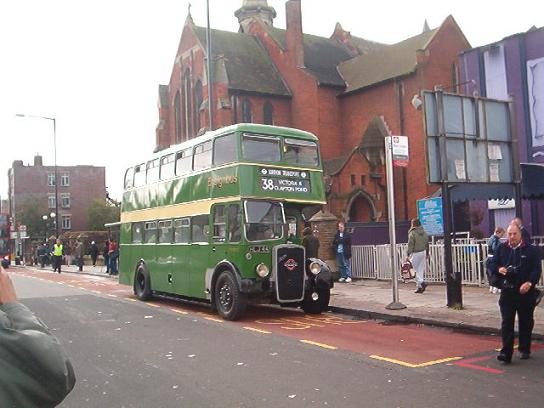
One of the guest vehicles was this Bristol double decker with Eastern Coachworks lowbridge body, seen here at Clapton Pond. It was new to Hants and Dorset in February 1949, and was one of a number of similar vehicles hired in by London Transport in 1949 and 1950 when they were short of buses. Note the L.T. sign on the radiator.
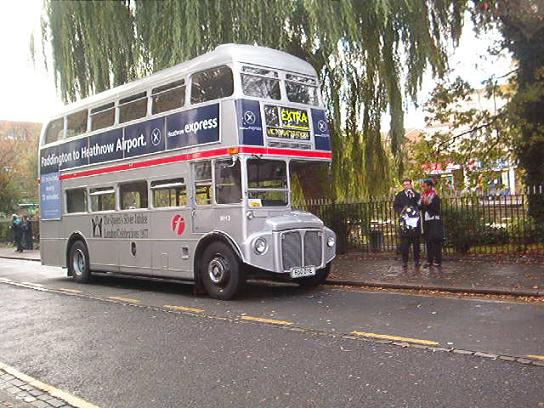
First Centrewest supplied 650 DYE, which carries fleetnumber SRM3 from its 1977 spell as one of the 25 Silver Jubilee buses. I also travelled on this bus on the Lancashire coast between Blackpool and Fleetwood in 1987.
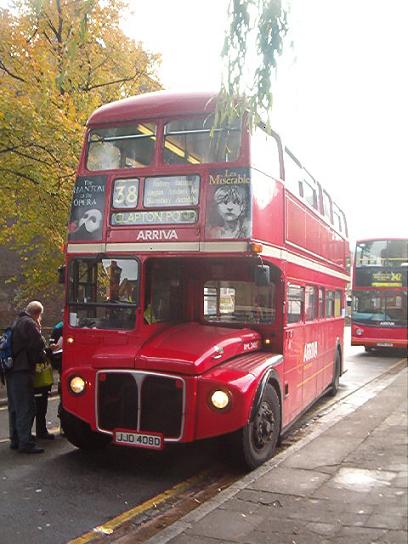
Photographed at the Clapton Pond terminus is RML2408, during the mid morning when the stance inspector was busily shuffling buses and crews to cover the failure of RM1312.
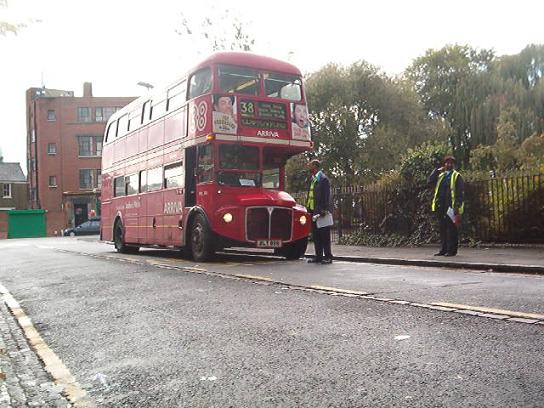
Also seen at Clapton was RML888, the only one of the first batch of RMLs seen in Arriva service during the day.
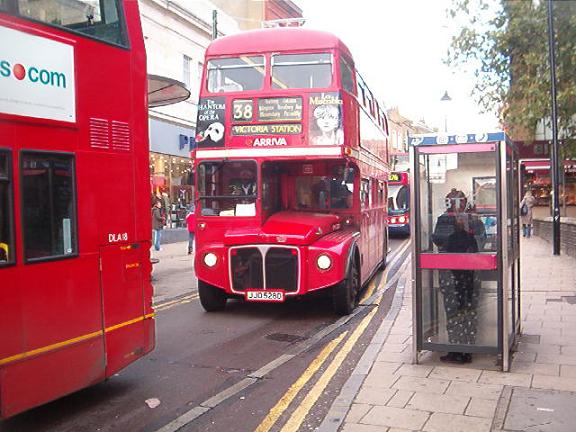
RML2528 was snapped in Mare Street, Hackney, near the entrance to Clapton garage, along with two Alexander bodied vehicles.
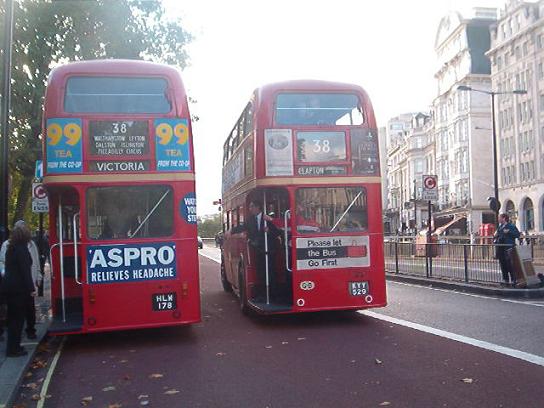
A rare sight in London in 2005 is two RT class buses side by side. HLW 178 (RT191) was new in 1947 and worked on the 38 from that time, allocated to Leyton garage. Overtaking it is RT1702, new in 1950. It still carries its G. B. badge from its promotional visit to Europe in 1951, promoting the Festival of Britain in that year.
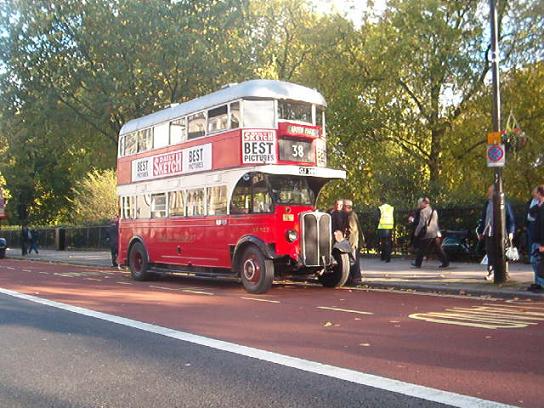
Brought up from Cobham museum for the day was ST922, which predates the formation of London Transport by three years. The petrol engined 52 seater bus was scheduled to do four round trips on part of the route.
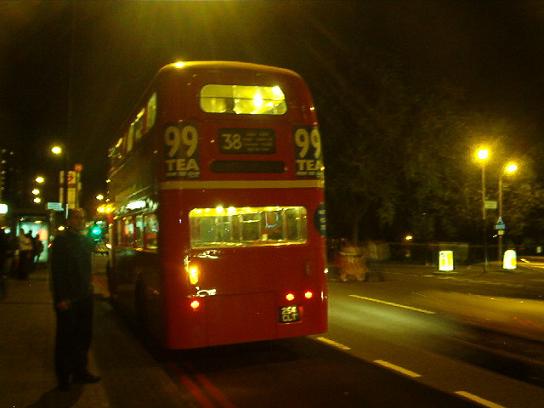
One of the extra guest buses in service on the last day of the 38 was the unique RMF1254. New in 1962, this was the only Routemaster out on the day without a rear platform.
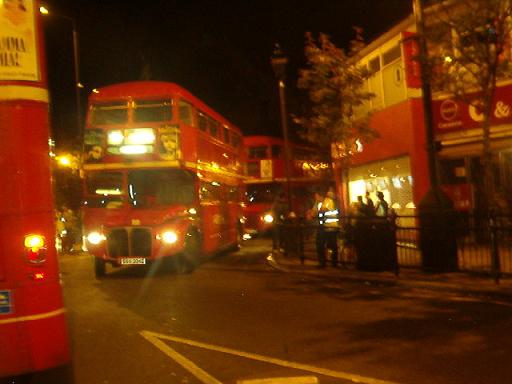
Clapton garage at 9 p. m. as the convoy of withdrawn buses leaves the garage for the last time. RML2334 leads the group in this photo, with another bus waiting to get in, which in turn was causing a traffic jam on Mare Street.
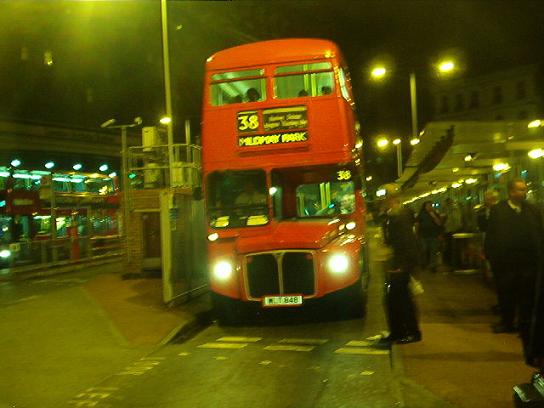
Back in Victoria around 10 p. m., and ex Blackpool RM848 prepares to depart for Mildmay Park on a short working.
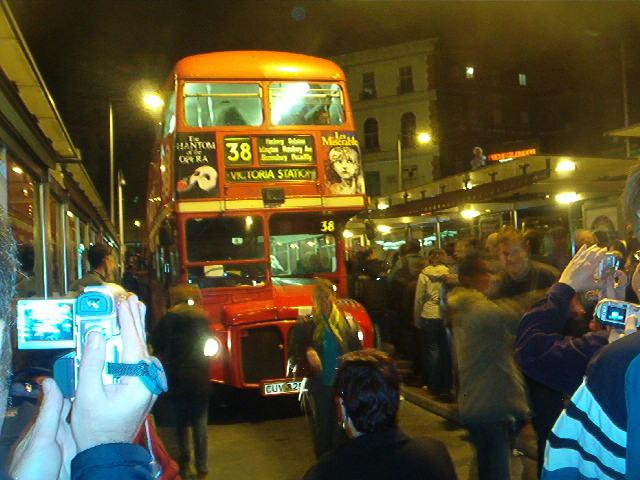
And another night-time view around 10.45 p.m. with RML2325 having just arrived in, and awaiting what would probably be its final departure.
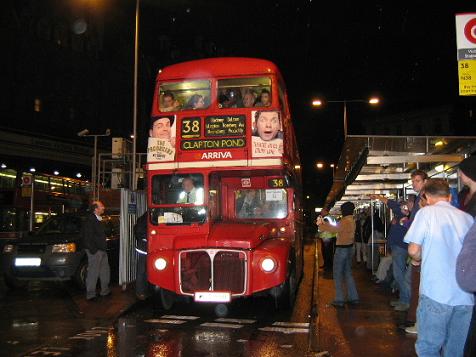
The last RML from Victoria was RML888, with a scheduled departure time of 00.35, the same bus having already done the last journey from Clapton at 23.39. Several of the RTs and RTW75 were also in Victoria around the same time, bringing half cab operation of the 38 to an end on a wet autumn night............... (photo by Kevin Horgan)
A press release from Capital Transport Campaign was issued on the day, as follows:
Memorial Service For Route 38 Routemaster Bus
Capital Transport Campaign will be marking the passing of the route 38 Routemaster bus at Clapton Pond at 10:45 am on Friday 28th October 2005, where this bus will end its final journey, later that day. Members of Capital Transport Campaign will stand for a moment's silence, holding a memorial wreath with the legend:
RIP Route 38 Routemaster:
passed away 28 October 2005, near Clapton Pond.
"Passengers will miss the reassuring presence of conductors on Route 38 and the cool comfort of simple and good ventilation in the summer months" says Cynthia Hay, spokesperson for Capital Transport Campaign.
"The symbolism of this final destination for the 38 Routemaster is unfortunate" adds Cynthia Hay, "as the area has had more than its share of non-accidental deaths in the recent past."
.....ends
Finally, a passenger observed on RML2401 was carrying a handwritten sign with the words "R.I.P. ROUTEMASTER BELOVED LONDON ICON".....
December 8th and 9th 2005 saw the end of London's Routemasters in regular all day service, with the enthusiasts specials running on the 8th, and the final journeys on the 9th. Due to work committments, this webmaster couldn't make it to London, so my associate editor did the honours instead. From the seven routes using RMs at the beginning of the year 2005, the year ended with only two part routes (heritage routes 9 and 15) left. While 2005 will be remembered by enthusiasts as the year London lost its last half cabs, lets not also forget the much more serious atrocity inflicted on the city's transport system on July 7th in which dozens of people lost their lives on tubes and a bus, and the case of mistaken identity two weeks later at Stockwell station. For many families these events will be recalled long after the loss of the last half cab London buses has faded from public memory.
Email Events diary Past events list Classified adverts Classic U.K. Buses Classic Irish Buses Classic Manx Buses